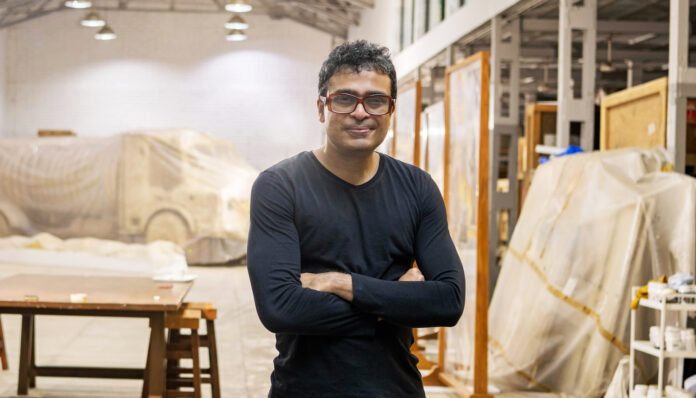DUBAI: Geometry and geography are at the core of Indian contemporary artist Jitish Kallat’s new exhibition in Dubai called “Order of Magnitude.”
Kallat, who is from Mumbai, is presenting his first solo exhibition in the Middle East in Dubai’s Alserkal Avenue until July 1.
The artist is showcasing paintings, multimedia installations, drawings and site-specific interventions that reflect his take on the relationship between the cosmic and the terrestrial.
Titled the “Integer Studies (Drawings from Life),” this project began by chance, Kallat told Arab News. (Supplied)
As soon as you walk into the spacious airy room, you see a line of drawings that rotate around the exhibition, resembling the horizon and the equator.
Titled the “Integer Studies (Drawings from Life),” this project began by chance, Kallat told Arab News.
“Through much of 2020, for some reason I used to have on my computer’s homepage the websites that reveal the number of us on the planet. This used to go on for a few months but I didn’t quite analyze it. It was a peculiar feeling,” the artist said.
“On Jan. 1, 2021, I came back from my run in the morning and had this instinct to draw. So that led to this drawing,” said Kallat as he pointed at the first frame of the perfectly lined series.
Kallat produced 365 artworks in 2021. (Supplied)
Each drawing, which features geometric shapes, is done using a pencil and paint. It also has three sets of numbers: The algorithmically-estimated world population, the number of new births and the death count recorded at the moment of the work’s creation.
Kallat produced 365 artworks in 2021, creating something new every day. In the exhibition, he was able to display whatever the walls could hold, and that was around five to six months of paintings, according to Kallat.
Alongside these artworks is a wall-sized painting titled “Postulates from a Restless Radius,” with the perimeter taking the form of the conic Albers projection of the Earth.
Alongside these artworks is a wall-sized painting titled “Postulates from a Restless Radius.” (Supplied)
The work begins as an unstable, cross-sectional grid — drawn in aquarelle pencil — that opens up the globe on a flat plane.
“I take the form of the map of the world, but then I start within that planetary form and use imagery that comes from under the ocean, suboceanic forms, celestial forms, bodily forms, botanical forms. So, it’s like working out multiple geometries in the world through a kind of abstraction,” explained Kallat, who has presented exhibitions around the world, including in Tokyo, Berlin, Milan, Sydney, Chicago and Brussels.
In the center of his exhibition, Kallat presents double-sided and multi-scopic photo works titled “Epicycles.”
In the center of his exhibition, Kallat presents double-sided and multi-scopic photo works titled “Epicycles.” (Supplied)
This series began during the early days of the COVID-19 pandemic with a hand-drawn journal capturing minute changes in Kallat’s studio, which he lived in for a while to avoid infecting his family.
“I started looking at things I probably never looked at, like a small crack in the studio wall. I started observing small tiny changes in my studio environment and keeping a drawing book of them,” he said.
He then populated the drawing book with images that come from the Family of Man exhibition organized by photographer Edward Steichen at the The Museum of Modern Art in New York in 1955.
The resulting prints combine the artist’s everyday observations with archival images of human solidarity taken by photographers from around the world. Composed on a lenticular surface, the depicted figures appear and disappear as one moves around the work, yielding a complex portrait of time.
He displays images from The Golden Record — a 12-inch gold-plated phonograph disc that traveled on NASA’s 1977 Voyager 1 and 2 space mission — resting on shelves along two opposite walls. (Supplied)
On the second floor of the exhibition, Kallat presents his immersive installation “Covering Letter (terranum nuncius).”
He displays images from The Golden Record — a 12-inch gold-plated phonograph disc that traveled on NASA’s 1977 Voyager 1 and 2 space mission — resting on shelves along two opposite walls.
Placed inside programmed LED frames, 116 parallax prints flicker in a breath-like cadence.
“They are all images and sounds that are currently in interstellar space, outside the scope of the solar system. They left planet earth in 1977,” he explained. “This object, in the empty space, might go on. It may be the only thing that survives us. And the thought was if such an object was found by an alien, what would we tell them?”
Placed inside programmed LED frames, 116 parallax prints flicker in a breath-like cadence. (Supplied)
The “Covering Letters” installation includes scientific, anatomical and cosmological diagrams in an attempt to encapsulate a summary of life on earth as it existed in 1977.
Permeating the exhibition space are the sounds of salutation to the universe that were included on The Golden Record in 55 languages.
As the two Voyager spaceships continue their journey in space, now over 14 billion miles away from earth, this work is a reminder of our world to an unknown other.
Kallat told Arab News: “I am very interested in some subtle invisible geometries. Every exhibition and every artwork has its own geometry that tries to reach out to some other intuitions through its geometry.”

